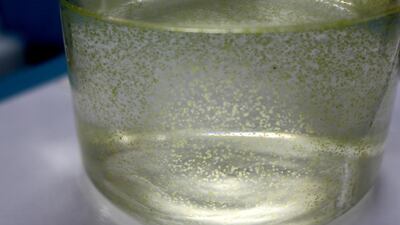ABU DHABI // The Ministry of Climate Change and Environment is collecting samples from the most recent algal bloom off Fujairah to better understand the risks it might pose to the marine environment.
Algal blooms, or red tides, are considered natural phenomena that occur when there is so much algae in the water that they appear on the surface.
The ministry said Noctiluca scintillans, a common algal species, is not harmful in small amounts but must be monitored as higher concentrations could pose environmental threats.
“Working with marine organisations and satellite image monitoring, we are able to give those involved early warnings,” said Dr Rashid Al Shihi, an oceanographer with the ministry.
“This algae has been in the region for five decades. It only becomes a problem when the number increases, which doesn’t seem to be the case this time.”
Algae contain chlorophyll, a colour pigment that allows them to gain nutrients through the sun’s light. When they appear on the surface, as in this incident, they block sunlight necessary for coral to survive.
Considered the foundational element to marine life, if coral dies it can completely wipe out marine ecosystems and their disappearance can cause more shoreline destruction from tropical storms.
Despite that, Dr Al Shihi said that at current concentrations the bloom in Fujairah was common and, as long as it did not last, it would not be a risk.
The bloom may have been triggered by a dust storm from northern Afghanistan, said Dr Maryam Al Shehhi, a research assistant at Masdar Institute of Science and Technology.
“Higher temperatures might have triggered the south-west monsoon in the Indian Ocean and that can cause welling,” said Dr Al Shehhi.
The algae is expected to disappear over summer, but if it gets out of hand there is not much that can be done to prevent a destructive bloom, such as one that wiped out entire species of coral and forced desalination plants to close along the east coast in 2009.
“Yes, aquaculture and toxins and pollution and climate change can contribute to the occurrence of an algal bloom, but what must be made clear is that this particular incident is coming not from the Gulf, but from the Indian Ocean,” said Dr Al Shihi.
“This is completely a natural phenomenon. We are monitoring it daily and currently the conditions of this algal bloom are not dangerous.”
A recent report published by the Emirates Wildlife Society in collaboration with the World Wildlife Fund said that climate change could be responsible for a higher occurrence of algal blooms.
“It has been suggested that climate pressures will influence marine planktonic systems globally, and it is conceivable that harmful algal blooms may increase in frequency and severity,” said the report last month.
The ministry will continue to monitor the algae and its findings will be published on the ministry website, along with the data from the last few years.
nalwasmi@thenational.ae

